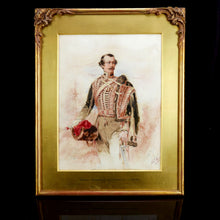Portrait of Lieutenant Henry Duberly, 8th King’s Royal Irish Hussars, 1849
- Regular price
- £3,400
- Sale price
- £3,400
- Regular price
-
- Unit price
- /per
Adding product to your cart
Overall: 48.5cm (19in) x 38cm (15in)
Watercolour and pencil. Three quarter length portrait of Henry Duberly, 8th (The King’s Royal Irish) Hussars in review order. Signed ‘Edward Hayes / Dublin’, dated and titled with sitter’s name on the mount. Contained in original gilt moulded frame, bearing the label of the picture dealer Thomas Cranfield, inscribed in ‘F.I. Duberly / Henry’s’ in ink verso. Image: 35.5cm (14in) x 26.7cm (10.5in).
Major Henry Duberly (1822–1890), paymaster to the 8th King's Royal Irish Hussars, is known to history as the husband of the feisty Fanny Isabella Duberly, a letter-writer and diarist of considerable talent, who reached print in both these forms as the only officer's wife in the field with the British Army throughout the Crimean War (1854-55). She later followed Henry when the 8th Hussars were sent to India in 1856, travelling on the SS Great Britain. She stayed with him throughout Central India campaign in the final months of the Sepoy Mutiny. She was adamant about accompanying him on campaign and told her sister that she would ‘stain my face and hands and adopt the Hindoo caftan and turban' rather than stay behind.
Read more
Henry was commissioned Ensign in 1839 and was promoted lieutenant in 1842. He met sixteen year-old Frances Isabella Locke in 1841 and married her at New Alresford in Hampshire in four years later. The Duberlys duly went to Ireland where the 8th Hussars were stationed and where the present portrait was commissioned by ‘FID’. That same year that Henry’s regiment escorted Queen Victoria and Prince Albert on their first visit to Dublin.

The month after Britain and France declared war on Russia in 1854 the Duberlys travelled to Plymouth and thence for Constantinople, where Fanny defied Lord Lucan by continuing to the war zone. In the Crimea Henry was duly present at the battles of the Alma, Balaclava, Inkerman, Tchernaya, the engagements at Bulganak, M’Kenzie’s Farm and the siege of Sebastopol. Meanwhile Fanny, with her aptitude for languages and skill as a horsewoman, became a well known figure not only to British officers but to the French who company she sometimes preferred. To the Turkish commander, Omar Pasha, she was a ‘beautiful woman with long flaxen curls’.
Her letters home were published anonymously by newspapers and blew the whistle on incompetence and negligence in high places.
Fanny proved to be Duberly’s greatest supporter while he never seemed to be jealous of his wife as the centre of attention. In the Crimea she successfully defied Lord Cardigan whom she detested despite portrayals to the contrary in popular fiction. At home Queen Victoria took a dim view of her and refused to accept a royal dedication of her published journal. Nonetheless Fanny was popular with the troops (who nicknamed her Mrs Jubilee) and many people in England. Her book met with some success and the iconic double portrait photograph of Henry in a goat skin coat over her his hussar uniform and Fanny mounted side-saddle on her favourite horse ‘Bob’ by Roger Fenton sold well.
The final word on the Duberlys might go to the 4th Dragoon Guards’ CO, who wrote of Fanny's conduct in the Crimea: 'They say she is not actually a ‘bad one’ but that she behaves in the most extraordinary way, riding and walking about with anybody, giving men every encouragement to flirt with her, but when the gentleman becomes rather too ardent in his admiration, she suddenly says "why you must forget that I am a married woman. I shall tell my husband of this, & we shall have such a laugh." They say that she has played this trick to several.’
Edward Hayes (1797-1864) Irish was a watercolourist and portrait painter. He studied drawing at the Dublin Society school and under Jospeh Samuel Alpenny. He practiced as a miniature painter in Kilkenny, Waterford and Clonmel while also teaching. He moved to Dublin and practiced as a miniature painter and exhibited frequently with the RHA. Hayes was elected a member of the RHA in 1861. His portrait of his teacher JS Alpenny, done while he was stil young, is held in the National Gallery of Ireland.










